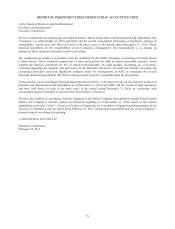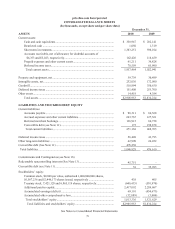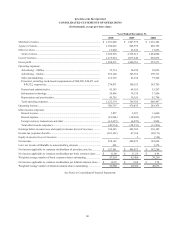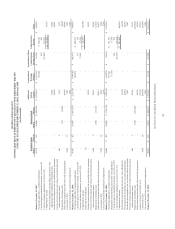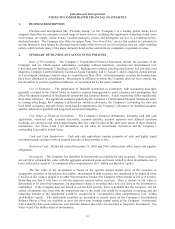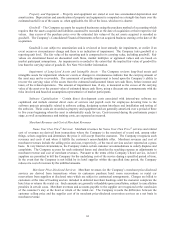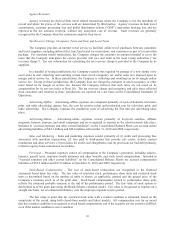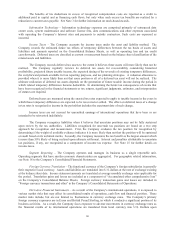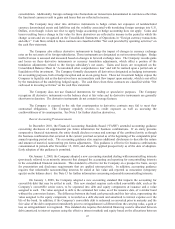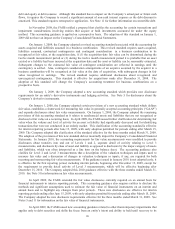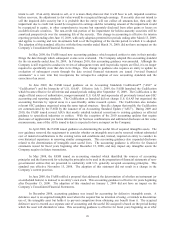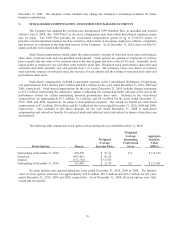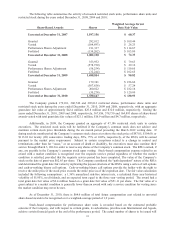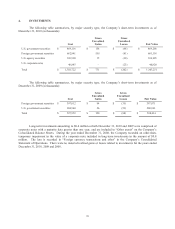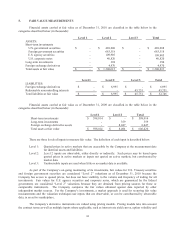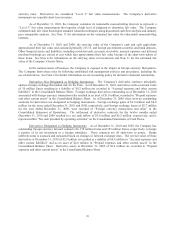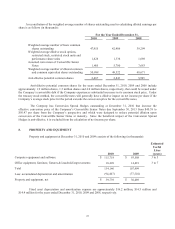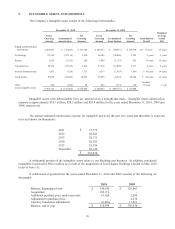Priceline 2010 Annual Report Download - page 162
Download and view the complete annual report
Please find page 162 of the 2010 Priceline annual report below. You can navigate through the pages in the report by either clicking on the pages listed below, or by using the keyword search tool below to find specific information within the annual report.88
debt and equity at debt issuance. Although this standard has no impact on the Company’s actual past or future cash
flows, it requires the Company to record a significant amount of non-cash interest expense as the debt discount is
amortized. This standard requires retrospective application. See Note 11 for further information on convertible debt.
In November 2008, the FASB ratified a proposal that clarifies the accounting for certain transactions and
impairment considerations involving entities that acquire or hold investments accounted for under the equity
method. This accounting guidance is applied on a prospective basis. The adoption of this standard on January 1,
2009 did not have an impact on the Company’s Consolidated Financial Statements.
On January 1, 2009, the Company adopted a revised accounting standard associated with the accounting for
assets acquired and liabilities assumed in a business combination. This revised standard requires assets acquired,
liabilities assumed, contractual contingencies and contingent consideration in a business combination to be
recognized at fair value, at the acquisition date, if (1) the acquisition-date fair value can be determined during the
twelve month measurement period or (2) during the twelve month measurement period it is probable that an asset
existed or a liability had been incurred at the acquisition date and the asset or liability can be reasonably estimated.
Subsequent changes to the estimated fair value of contingent consideration are reflected in earnings until the
contingency is settled. Also, contingent consideration arrangements of an acquiree assumed by the acquirer in a
business combination will be recognized at fair value at the date of acquisition, with subsequent changes in fair
value recognized in earnings. The revised standard requires additional disclosures about recognized and
unrecognized contingencies. This standard is effective for acquisitions made after December 31, 2008. The
adoption of this standard will change the Company’s accounting treatment for business combinations on a
prospective basis.
On January 1, 2009, the Company adopted a new accounting standard which provides new disclosure
requirements for an entity’s derivative instruments and hedging activities. See Note 5 for disclosures about the
Company’s derivative instruments.
On January 1, 2008, the Company adopted certain provisions of a new accounting standard which defines
fair value, establishes a framework for measuring fair value in generally accepted accounting principles (“GAAP”)
and expands disclosures about fair value measurements. On January 1, 2009, the Company adopted the remaining
provisions of this accounting standard as it relates to nonfinancial assets and liabilities that are not recognized or
disclosed at fair value on a recurring basis. In April 2009, the FASB issued further clarification for determining fair
value when the volume and level of activity for an asset or liability had significantly decreased and for identifying
transactions that were not conducted in an orderly market. This clarification of the accounting standard is effective
for interim reporting periods after June 15, 2009, with early adoption permitted for periods ending after March 15,
2009. The Company adopted this clarification of the standard effective for the three months ended March 31, 2009.
The adoption of the provisions of this new standard did not materially impact the Company’s Consolidated Financial
Statements. In January 2010, the accounting requirements for fair value measurements were modified to provide
disclosures about transfers into and out of Levels 1 and 2, separate detail of activity relating to Level 3
measurements, and disclosure by class of asset and liability as opposed to disclosure by the major category of assets
and liabilities, which was often interpreted as a line item on the balance sheet. The accounting guidance also
clarifies for Level 2 and Level 3 measurements that a description of the valuation techniques and inputs used to
measure fair value and a discussion of changes in valuation techniques or inputs, if any, are required for both
recurring and nonrecurring fair value measurements. If the guidance issued in January 2010 is not adopted early, it
is effective for the first reporting period, including interim periods, beginning after December 15, 2009, except for
the requirement to provide detail activity of Level 3 measurements, which will be effective beginning after
December 15, 2010. The Company adopted this 2010 guidance effective with the three months ended March 31,
2010. See Note 5 for information on fair value measurements.
In April 2009, the FASB extended the fair value disclosures currently required on an annual basis for
financial instruments to interim reporting periods. This accounting guidance also requires entities to disclose the
methods and significant assumptions used to estimate the fair value of financial instruments on an interim and
annual basis and to highlight any changes from prior periods. These new disclosures are effective for interim
reporting periods ending after June 15, 2009, with early adoption permitted for periods ending after March 15, 2009.
The Company adopted the new disclosure requirements effective for the three months ended March 31, 2009. See
Notes 5 and 11 for information on the fair value of financial instruments.
In April 2009, the FASB issued new accounting guidance related to other-than-temporary impairments that
applies only to debt securities and shifts the focus from an entity’s intent and ability to hold until recovery to its


